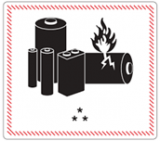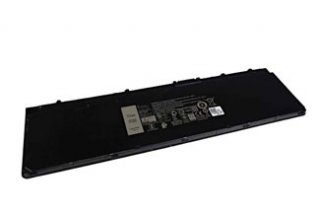Half Used Battery Can Be Used Again
Find information about the types of batteries used in households and how to manage them when they are no longer needed.

Certain batteries should Not go in household garbage or recycling bins. This page can inform y'all on how to manage these batteries safely. Waste material batteries can always exist recycled or taken to household chancy waste collection points.
To forbid fires from lithium-ion batteries, tape bombardment terminals and/or place batteries in dissever plastic bags and never put these batteries in household garbage or recycling bins.
On this page:
- Background
- Single-Use Batteries
- Rechargeable Batteries
- Automotive Batteries
- Federal Bombardment Laws
- State Battery Recycling Laws
Background
Every year in the The states, millions of unmarried use and rechargeable batteries are bought, used and recycled or disposed of in the trash. Batteries come in diverse chemistries, types and sizes to fit their utilize.
- Single-use batteries can by and large be removed from the device when they stop powering the device.
- Rechargeable batteries may be removable or permanently attached to the device.
The increased need for batteries can be traced largely to the rapid increment in utilise of pocket-size portable electronics, power tools, and other everyday items, as well as the increment in "smart" products, such as small and large appliances and automobiles.
Batteries are manufactured using dissimilar mixtures of chemic elements designed to encounter customers' ability and functioning needs. Batteries can contain metals such as mercury, lead, cadmium, nickel and silverish, which can pose a threat to human wellness or the environment when improperly managed at the end of their service life. Battery types are identified past marking and labeling, not past the battery's shape or the color of the label.
Some batteries may likewise incorporate materials such every bit cobalt, lithium and graphite that are considered critical minerals by the United states Geological Survey. Critical minerals are raw materials that are economically and strategically of import to the United States and have a high supply gamble potential and for which at that place are no piece of cake substitutes. Consequently, every effort should be made to recycle and recover these materials to ensure they will be available for generations to come.
Once a battery is no longer useful, the type and chemical science of the battery determines which of the various waste management options to utilise. It is important to manage batteries correctly according to their type because some batteries can cause a gamble to safety and health if mismanaged at the end of their lives. Batteries tin can have enough energy to injure or start fires even when used and when they announced to exist discharged. For rubber, think that not all batteries are removable or serviceable past the user—heed battery and product markings regarding safety and use for all types of batteries.
Single-Use Batteries
| Type | Uses and Description | Disposal |
|---|---|---|
| Alkaline and Zinc-Carbon |
| Some reclamation companies recycle these batteries; check with your local or state solid waste say-so for management options. In most communities, alkaline and zinc carbon batteries tin be safely put in your household trash. EPA recommendation: send used alkaline metal and zinc carbon batteries to bombardment recyclers or cheque with your local or state solid waste authority. |
| Button-Jail cell or Coin |
| Button-prison cell or money batteries can be a potential swallowing take a chance; store them out of the reach of immature children. Management requirements are based on the battery's chemistry. They tin can be brought to specialized bombardment recyclers, participating retailers that provide battery takeback services or local household hazardous waste drove programs. Contact the manufacturer or local solid waste matter authorisation for additional management options. Handling precautions: Place each battery in separate plastic bags or place non-conductive record (e.g., electrical tape) over the battery'southward terminals or around the entire push. A lithium battery may spark and cause fires if damaged or the terminal ends touch. If the battery becomes damaged, contact the manufacturer for specific handling data. EPA recommendation: Check for the word "lithium" marked on the battery. Do not put button-prison cell, coin, or lithium single utilize batteries in the trash or municipal recycling bins. Find a recycling location virtually you:
|
| Lithium Unmarried-Utilise |
|
Rechargeable Batteries
| Type | Uses and Description | Disposal |
|---|---|---|
| Nickel Cadmium (Ni-Cd) |
| Removable batteries: Removable rechargeable batteries can exist brought to specialized battery recyclers, participating retailers that provide battery takeback services, or local household hazardous waste collection programs. Contact the manufacturer or your local household waste authority for other management options. Non-removable batteries contained in electronic devices: Entire devices tin be brought to certified electronics recyclers, participating retailers that provide electronics takeback services, or local electronics or household chancy waste matter drove programs. Handling precautions: Place each bombardment in a separate plastic bag or place non-conductive record (due east.one thousand., electric tape) over the bombardment's terminals. Handle any damaged battery with care and advisable personal protective equipment. If a lithium-ion battery becomes damaged, contact the battery or device manufacturer for specific treatment data. EPA recommendation: Look for labels identifying battery chemical science. Do not put rechargeable batteries in the trash or municipal recycling bins. Find a recycling location nigh you: The following links go out the site
|
| Lithium-Ion (Li-ion) |
| |
| Nickel Metal Hydride (Ni-MH) |
| |
| Nickel-Zinc (Ni-Zn) |
| |
| Small-Sealed Atomic number 82 Acrid (Atomic number 82) |
|
Automotive Batteries
There are several types and applications of batteries used in vehicles today. There are automotive starting batteries used with internal combustion engines, large electric vehicle battery packs that power the vehicle and minor batteries that power accessories such as remote door locks or back up the figurer's retentiveness.
| Type | Uses and Description | Disposal |
|---|---|---|
| Lead-Acid |
| Return to the battery retailer or your local solid or household hazardous waste drove programme. Treatment precaution: Contains sulfuric acid and pb. When handling the battery, follow all warnings and instructions on the bombardment. EPA recommendation: Return atomic number 82-acid batteries to a bombardment retailer or local household chancy waste material collection program ; do not put atomic number 82-acid batteries in the trash or municipal recycling bins. |
| Medium and Large-Calibration Li-ion |
| Because of the size and complexity of these battery systems, medium and large-scale Li-ion batteries may non be able to exist removed by the consumer. Refer to the manufacturer'southward instructions and heed warnings and safety instructions.
EPA recommendation: Contact the manufacturer, auto dealer or company that installed the Li-ion battery for management options; practice not put in the trash or municipal recycling bins. |
Federal Battery Laws
- Public Law 104-142: The Mercury-Containing and Rechargeable Battery Management Human action: This police force was enacted to stage out the use of mercury-containing batteries and provide for the recycling of nickel cadmium, small sealed lead-acid batteries, and certain other rechargeable batteries.
State Battery Recycling Laws
Some states have enacted battery recycling laws for various types of consumer batteries. To see a map of state battery laws, get to the Call2Recycle website.
Source: https://www.epa.gov/recycle/used-household-batteries

0 Response to "Half Used Battery Can Be Used Again"
Post a Comment